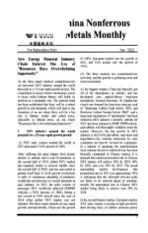The Ministry of Land and Resources Published the “Three-Rate” Indicator for Seven Minerals Including Iron Ore and Copper
2014-08-15
In order to strengthen the supervision and administration of rational exploitation of mineral resources including iron, copper, lead, zinc, rare earth, sylvine and fluorite, the Ministry of Land and Resources has published the Minimum Three-rate Requirements for the Rational Exploitation of Mineral Resources including Iron, Copper, Lead, Zinc, Rare Earth, Sylvine and Fluorite (for trial implementation).
Extract recovery rate, concentration recovery rate and comprehensive utilization rate are the main indicators for assessing the conservation and comprehensive utilization of mineral resources. This time the Ministry of Land and Resources has published the requirements for the extract recovery rate, concentration recovery rate and comprehensive utilization rate under different conditions for seven minerals including iron, copper, lead, zinc, rare earth, fluorite and sylvine, and the extract recovery rate of large open-pit iron mines should not be lower than 95%.
The extract recovery rate of medium and small open-pit iron mines should not be lower than 90%. The extract recovery rate of underground iron mines is specified to be at six levels between 75% -83%; for copper mines, the extract recovery rate for large open-pit copper mines should not be lower than 95%, and that of medium and small mines should not be lower than 92%. With respect to underground copper mines, based on the thickness of the ion body and the difference in the copper grade, 9 levels between 75%-92% are specified; for lead-zinc mines, the extract recovery rate for large open-pit lead-zinc mines should not be lower than 95%, and that of medium and small mines should not be lower than 92%, while for underground mines, 27 levels of between 75%-92% are specified based on the thickness of the ore body, the type of the ore and the grade of lead and zinc; rare earth is split into two categories of rock type and ionic type – the extract recovery rate for ionic type of rare earth using leap leaching technology should not be lower than 87% (leaching) or 70% (wholephase), and that of ionic rare earth using local immersion technology should not be lower than 84% (leaching) or 67% (whole-phase); the extract recovery rate of solid sylvine ore should not be lower than 61%, and that of the chloride brine saline lake potash mine should not be lower than 70%; the extract recovery rate of open-pit fluorite mines should not be lower than 90%, and that of underground mines should not be lower than 80% and 73%.
The circular also contains detailed specification for the concentration recovery rate and the comprehensive utilization rate of the seven minerals including iron, copper, lead, zinc, rare earth, fluorite and sylvine.
杂志排行
China Nonferrous Metals Monthly的其它文章
- State Grid Plans to Invest RMB403.5 Billion in 2014, Benefiting Non-ferrous Materials
- It is Imperative for Chinese Enterprises to Change their Investment Model in Overseas Mining Industry
- Tibet’s Duolong Is Expected to Become a World-class Copper-Gold Mining Base
- The Country’s New Policy Represents a Major Challenge for Lead Enterprises in Henan
- Chifeng to Build RMB200 Billion Nonferrous Metals Club
- Export Volume Increases While Price Drops: Three Major Factors Weakens Our Country’s Rare Earth Industry
